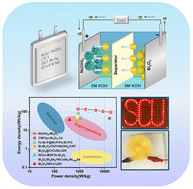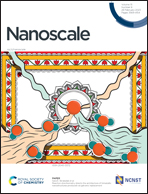Battery-like bismuth oxide anodes for soft-packed supercapacitors with high energy storage performance†
Abstract
Bismuth compounds are of interest because of abundant reserves and high theoretical capacity for use as anodes in supercapacitors. In this work, bismuth oxycarbonate is synthesized by a hydrothermal method, and bismuth oxide is obtained by the subsequent calcination process, both of which possess high specific capacity. In particular, Bi2O3 possesses a specific capacity of 1178 F g−1 (1178 C g−1, 327 mA h g−1) at a current density of 1 A g−1, and still retains 94.9% capacity at 20 A g−1, indicating excellent rate capability. Furthermore, Ni(OH)2 is prepared with a specific capacity of 2447 F g−1 at 1 A g−1. Using Bi2O3 as the anode and Ni(OH)2 as the cathode, respectively, the soft-packed supercapacitors are assembled with a large voltage window of 1.75 V. The energy density is as high as 139.7 W h kg−1 at a power density of 874.8 W kg−1. Even at 18 000 W kg−1, the device retains an energy density of 94 W h kg−1. Connecting two devices in series as a power source can light up 88 light emitting diodes (LEDs) for 2 hours, and drive a tiny fan to run for 18 seconds. The work provides new ways for the practical application of supercapacitors.



 Please wait while we load your content...
Please wait while we load your content...